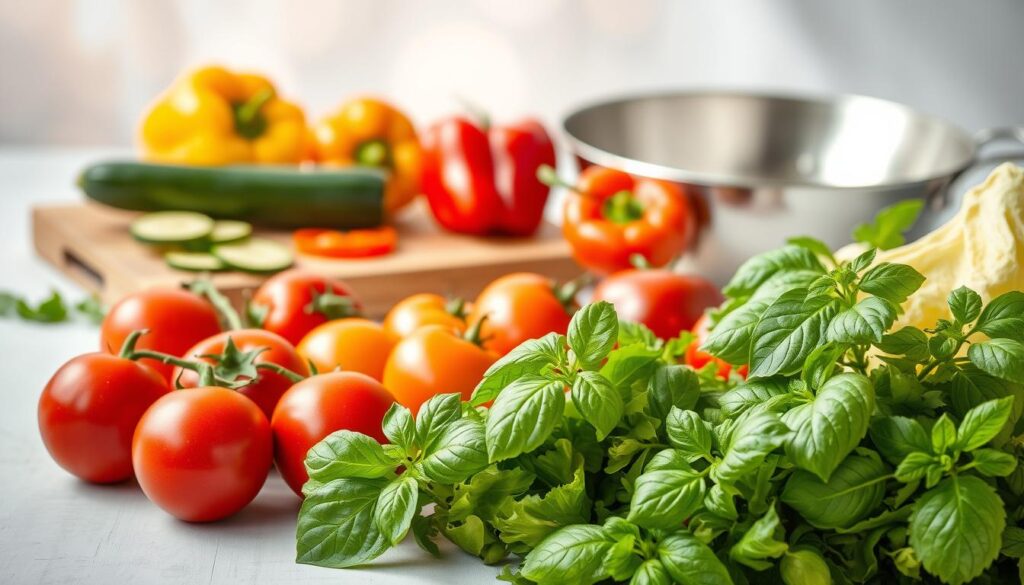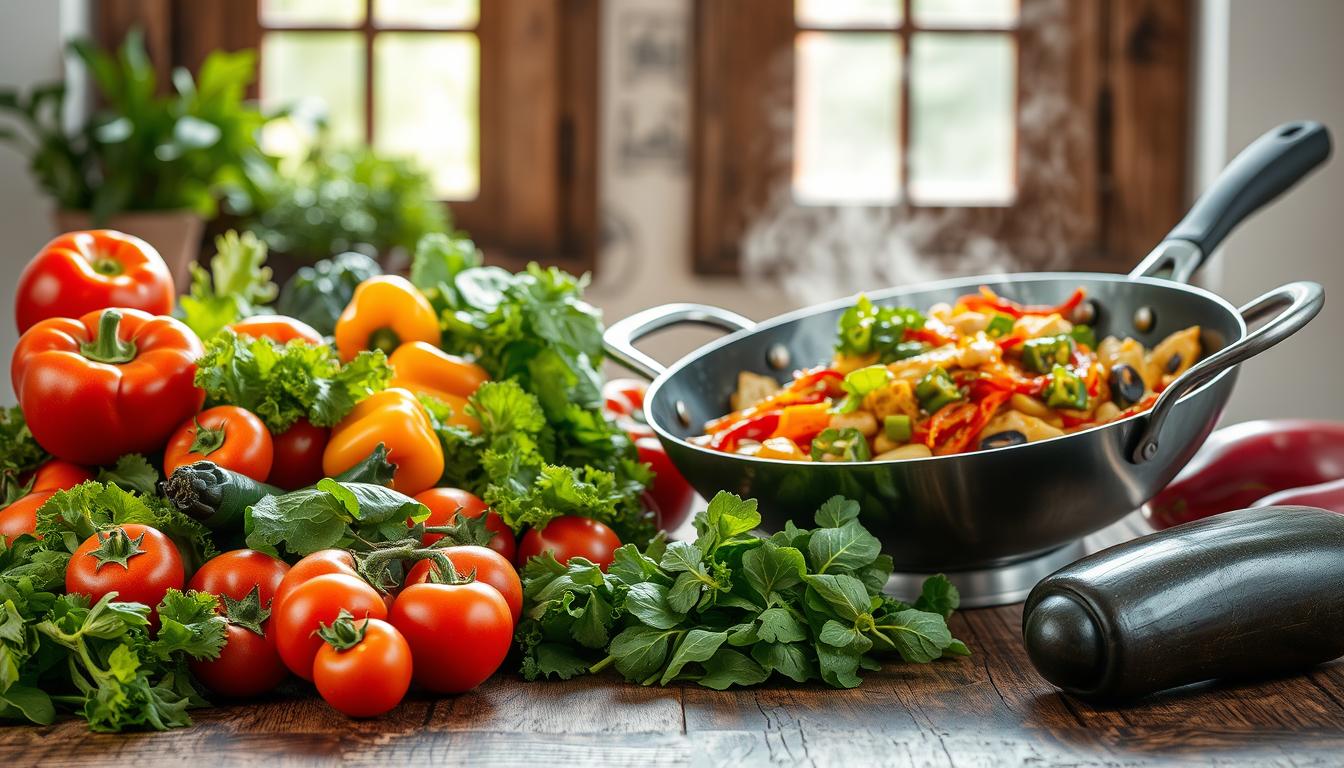Exploring seasonal cooking is key. It’s important to use fresh, seasonal ingredients in our lunch recipes. These ingredients are at their best during certain months, making our summer dishes even better.
By choosing seasonal ingredients, we add variety and nutrition to our meals. We also support local farmers and help the environment. Fresh salads and summer dishes are perfect for busy days when it’s warm outside.
Seasonal ingredients keep us healthy and full of energy all day. Citrus, elderflower, and berries are popular in summer for desserts and baked goods. We can also use fresh asparagus and rhubarb in spring, and tomatoes and corn in summer. This makes our lunch ideas both tasty and healthy.
Al fresco dining is on the rise. It’s the perfect time to get creative with our seasonal recipes.
Choosing seasonal ingredients means we get fresh, nutritious produce. It also helps local farmers and is better for the environment. Seasonal produce is often cheaper because it costs less to transport and store.
CSA programs and local farmers markets make it easy to find fresh, seasonal ingredients. They inspire us with new recipes and ideas.
Key Takeaways
- Incorporating seasonal ingredients into our lunch recipes can add variety and nutrition to our meals
- Seasonal ingredients are typically more cost-effective due to lower transportation and storage costs
- Using seasonal ingredients supports local farmers and reduces our carbon footprint
- Fresh salads and summer dishes are great options for busy lifestyles during warmer months
- Community-supported agriculture (CSA) programs and local farmers markets can provide access to fresh, seasonal ingredients
- Seasonal eating can reduce the risk of chronic diseases and provide a mix of diverse vitamins and minerals
- Seasonal recipes can be quick, easy, and delicious, making them perfect for lunch ideas
Why Seasonal Ingredients Matter
Healthy eating starts with seasonal ingredients. They add more flavor and nutrition to your meals. Plus, they help local farmers and cut down on carbon emissions. Choosing seasonal ingredients means you get tasty, healthy meals that are good for you and the planet.
Seasonal eating has many perks:
- Fresher and more flavorful ingredients
- Reduced carbon footprint
- Support for local farmers
Using seasonal ingredients boosts your meal’s nutritional value. Adding a variety of fruits and veggies to your diet ensures you get all the nutrients you need. Whether you’re searching for new recipes or fresh ingredients, there are plenty of resources to help you.
Spring Ingredients to Freshen Your Meals
Spring is here, and it’s time to refresh your meals with new ingredients. Adding seasonal recipes to your diet can make your food taste better and be healthier. Try using asparagus, peas, and radishes in your lunch ideas and healthy seasonal meals.
These ingredients are not only tasty but also full of good stuff for your body. Asparagus is full of vitamin C and fiber. Peas are packed with protein and fiber. Radishes add a spicy flavor and are rich in vitamin C and potassium. Using them in your meals can make your food both healthy and tasty.
Here are some ideas for using these ingredients:
- Adding asparagus and peas to a spring salad for a burst of flavor and color
- Using radishes in a refreshing salad or as a topping for whole grain bread
- Creating a hearty soup with asparagus and peas for a comforting and nutritious meal
By using seasonal recipes and adding spring ingredients to your meals, you can make delicious and healthy seasonal meals. So, why not get creative and start cooking with these fresh and tasty ingredients today?
| Ingredient | Nutritional Benefits |
|---|---|
| Asparagus | Rich in vitamin C and fiber |
| Peas | High in protein and fiber |
| Radishes | Rich in vitamin C and potassium |
Summer Ingredients for Bright Flavors
Summer is a great time to add bright flavors to your meals. Use seasonal ingredients like tomatoes, corn, zucchini, and bell peppers. These fresh ingredients can make a variety of delicious lunch ideas.
Try making a summer salad with tomatoes, corn, and zucchini. Or grill bell peppers and serve them as a side dish. You can also make a tomato and corn soup or a zucchini and bell pepper stir-fry.
Here are some tips for using these summer ingredients in your meals:
- Use fresh ingredients to create a variety of salads, such as a caprese salad with tomatoes, mozzarella cheese, and basil.
- Grill or roast summer vegetables like zucchini, bell peppers, and corn to bring out their natural sweetness.
- Try making a seasonal soup like a tomato and corn soup, or a creamy zucchini soup.
By using these summer ingredients, you can make delicious and healthy lunch ideas. So why not get creative and start cooking with fresh ingredients today?

| Ingredient | Calories per serving | Fat per serving | Sodium per serving | Protein per serving |
|---|---|---|---|---|
| Tomatoes | 22 | 0.2g | 1mg | 1g |
| Corn | 80 | 1g | 10mg | 2g |
| Zucchini | 25 | 0.5g | 5mg | 1g |
| Bell Peppers | 49 | 0.2g | 2mg | 1g |
Fall Ingredients to Cozy Up Your Dishes
As fall comes, we all look forward to making seasonal recipes. The kitchen is full of fresh ingredient ideas. You can use pumpkins, sweet potatoes, apples, and Brussels sprouts in many ways. In fact, 50% of people buy more seasonal ingredients in fall than in other seasons.
Some favorite fall ingredients are:
- Pumpkins, which are low in calories and rich in beta-carotene
- Sweet potatoes, which are high in fiber and vitamins A and C
- Apples, which are a good source of fiber and vitamin C
These ingredients can make many healthy eating dishes. For example, you can make a pumpkin soup with roasted pumpkins, onions, and garlic. Serve it with cream and a sprinkle of nutmeg.
Using seasonal recipes also helps local farmers and the environment. So, let’s get creative in the kitchen this fall. Your taste buds and the planet will appreciate it.
| Ingredient | Nutritional Benefits |
|---|---|
| Pumpkin | Low in calories, rich in beta-carotene |
| Sweet Potato | High in fiber and vitamins A and C |
| Apple | Good source of fiber and vitamin C |
Winter Ingredients to Keep You Warm
Winter is the perfect time to add healthy seasonal meals to your diet. Use fresh ingredients like root vegetables, dark leafy greens, and citrus fruits in your recipes. These add flavor, nutrition, and health benefits to your meals.
Winter ingredients include kale, Brussels sprouts, and sweet potatoes. You can use them in soups, stews, and side dishes. Try a winter salad with citrus and greens or add root veggies to a hearty stew. These meals will keep you warm and nourished.
Visit your local farmers’ market for fresh, seasonal produce. This makes your meals healthy and delicious while supporting local farmers. Using fresh ingredients in your recipes means you can enjoy healthy meals all winter.
Using winter ingredients in your meals has many benefits. They are high in vitamins A, C, and K. They also support local farmers and add flavor and variety to your meals.
- High nutritional value, with many winter vegetables being rich in vitamins A, C, and K
- Support for local farmers and the local economy
- Increased flavor and variety in your meals
How to Choose Fresh Seasonal Ingredients
Choosing fresh seasonal ingredients is key to making tasty and healthy meals. Visit farmers’ markets or learn about produce seasons to find the best ingredients. Fresh ingredients make your dishes taste better and are more enjoyable to eat.
Here are some tips for picking quality ingredients:
- Look for produce without visible damage or spoilage
- Choose ingredients in season for better taste and freshness
- Pick local and sustainable options when you can
Using fresh ingredients in your seasonal recipes leads to healthy and tasty lunch ideas. For instance, a salad with fresh, local veggies is a quick and nutritious meal. Plus, using fresh ingredients helps reduce waste and supports local farmers, making it a green choice.
Here is a table summarizing the benefits of choosing fresh seasonal ingredients:
| Benefit | Description |
|---|---|
| Improved flavor | Fresh ingredients taste better and have more texture |
| Increased nutrition | Seasonal produce is often more nutritious because it’s picked sooner |
| Supports local agriculture | Buying in-season foods helps small-scale farms stay sustainable |
Creative Ways to Use Seasonal Ingredients
Exploring seasonal recipes opens up a world of possibilities. By using fresh ingredients, you can make meals that taste great and are good for you. Start by trying new ingredients and flavors. Add seasonal fruits and veggies to salads or use them as sandwich toppings.
Here are more ideas to use seasonal ingredients:
- Put them in soups and stews for more taste and nutrients
- Use them as a base for homemade sauces and marinades
- Add them to baked goods for extra flavor and moisture
Being creative with seasonal ingredients can elevate your cooking. It also brings many health benefits. So, why not try it out and see what tasty dishes you can make with fresh ingredients and seasonal recipes?
Meal Prep with Seasonal Ingredients
Meal prep saves time and ensures you eat healthy seasonal meals. Planning meals around produce seasons makes seasonal lunch recipes both tasty and healthy. Using fresh ingredients is essential for great meal prep.
Planning Weekly Meals
Weekly meal planning keeps you organized and uses the freshest ingredients. Make a list of your favorite seasonal lunch recipes and plan meals around them. A meal planning template can also help you stay on track.
Batch Cooking Tips
Batch cooking is a smart way to prep healthy seasonal meals ahead. Cook a big batch of something like roasted veggies and use it in various recipes. This saves time and cuts down on waste.
Storing Leftovers
Properly storing leftovers is key in meal prep. Use airtight containers and label them with date and contents. This keeps your fridge organized and ensures you use the freshest ingredients. Follow these tips for delicious and healthy seasonal meals all year round.
Nutritional Benefits of Seasonal Produce
Healthy eating is key for good health. Using seasonal recipes in your diet offers many benefits. By picking fresh ingredient ideas that are in season, you get the most nutrients.
Some main advantages of eating seasonal produce include:
- Higher nutrient content: Seasonal produce has more vitamins, minerals, and antioxidants than out-of-season produce.
- Reduced environmental impact: Picking seasonal and local foods cuts down on carbon footprint from transporting out-of-season produce.
- Support for sustainable farming: Local farms that grow seasonally use better farming methods. This helps soil health and biodiversity.
Eating seasonal produce also meets your body’s needs at different times. For example, citrus fruits are full of vitamin C. This vitamin is great for your immune system in winter.

By adding seasonal recipes and fresh ingredient ideas to your meals, you get more nutrients. You also help sustainable farming. So, why not try it and enjoy the health benefits of healthy eating with seasonal produce?
| Season | Produce | Nutritional Benefits |
|---|---|---|
| Winter | Citrus fruits | High in vitamin C |
| Summer | Stone fruits | Rich in beta-carotenes |
| Fall | Apples | High in fiber and antioxidants |
Conclusion: Embracing Seasonal Cooking for Every Meal
Seasonal cooking is rewarding and nourishing for families. It lets everyone enjoy fresh ingredients and healthy eating. Start by planning meals together, so everyone can share their favorite dishes.
Don’t be shy to try new recipes with seasonal ingredients. Visit local farmers’ markets or gardens for unique produce. This way, you can always have fresh, nutritious food ready.
Seasonal cooking connects you with nature and creates lasting memories. It’s a way to nourish your body and build traditions with your family. Enjoy the flavors and let the seasons guide you to a healthier lifestyle.

